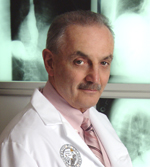
Marvin I. Schwarz, MD
By Teresa Barnes
Though Marvin I. Schwarz, MD, stepped down from his position as head of the Pulmonary Sciences and Critical Care Medicine Division at the University of Colorado Medical Center several years ago, he isn’t ready for retirement. The 74-year-old pulmonologist and lung disease researcher seeks a cure for a disease he began investigating more than 40 years ago—pulmonary fibrosis.
Before he hangs up his lab coat, Schwarz says he wants to be able to predict which patients are at the highest risk. “I want to find a drug that catches this early in the process and stops it in its tracks,” Dr. Schwarz adds.
As one of the world’s preeminent experts on PF, Schwarz research has been published in more than 300 articles, and he has earned several career awards, including the Society’s prestigious Trudeau Medal in 2008.
“Marvin Schwarz has had a long and distinguished career helping patients suffering from interstitial lung disease, teaching physicians the best therapies for this condition, and delving into its root causes and clinical characteristics, all while attempting to find its cure,” says ATS Foundation Chair James F. Donohue, MD, professor of medicine at the University of North Carolina, School of Medicine, Department of Medicine.
In the 1970s and 1980s, while much research attention was moving toward cancer, Schwarz kept his focus on ILD and encouraged other researchers, many of them his students at one time or another, to do the same.
“Marvin’s leadership and dedication to the field has personally inspired me to pursue a career in interstitial lung disease, despite the difficult challenges in caring for patients and a lack of clarity in its etiology,” says Gregory P. Cosgrove, MD, assistant director of the Interstitial Lung Disease Program and associate professor at National Jewish Health & University of Colorado–Denver.
Dr. Schwarz has treated thousands of patients with PF, and he’s seen many succumb to the relentless lung disease. In 2001, Schwarz was a founding board member of the Coalition for Pulmonary Fibrosis, a nonprofit organization focused on patient support and advocacy for research.
“Marvin’s commitment to better understanding of the causes and treatment of interstitial lung disease has been without peer,” says PF expert Talmadge E. King, Jr., MD, chair of the Department of Medicine at UCSF. “In addition, he spawned a generation of others interests in the disease.”
When David A. Schwartz, MD, now chairman of the Department of Medicine at the University of Colorado, opened a genomics research lab at National Jewish Health in Denver, he asked Dr. Schwarz to work alongside him, and the pair’s work has resulted in one of the few major discoveries in the history of the disease, a renegade protein called MUC5B.
The researchers hypothesize that excess mucus production caused by the MUC5B variant could slow clearance of mucus contaminated with irritants and toxins and interfere with the repair of air sacs damaged by these contaminants. Another scenario suggests that the genetic variation could trigger the production of mucus in areas where it is not normally present.
Drs. Schwarz and Schwartz are also working in a relatively new area of research—examining PF in West Highland white terrier dogs (or Westies), which might help better define the disease and identify treatment targets much faster than in human research—something Schwarz believes would make a huge impact over strictly human drug development.
They also developed simpler ways of phenotyping that can be applied to all PF trials—or the use of information such as age, sex and smoking history along with results of a high resolution computer topography (CT) scan.
“We have to look back and forward,” Dr. Schwarz. “We must look at old studies – the genotype cause of PF and response to treatment and look at lung specimens and the gene expression profiles and we must look at the pattern of gene signatures.”
The two believe the huge need in future clinical trials is to look at molecular phenotyping in addition to clinical phenotyping. “What we would do with the clinical phenotype is to add the genetic abnormality or the genotype to that,” Schwarz explains. “The molecular phenotype is actually an expression of what genes (normal or abnormal) are being up or down regulated because of the lung damage and fibrosis.”
Dr. Schwarz says having no approved treatment doesn’t mean there is no way to treat patients. For example, treating comorbid areas such as sleep apnea and reflux helps survival, he says.
“There are a lot of things you can do to improve people’s lives,” Dr. Marvin Schwarz says. “We can improve their outcomes. That is one thing we have learned in the many years.”
Teresa Barnes is vice president of patient outreach and program support for the Coalition for Pulmonary Fibrosis and chair of the ATS Public Advisory Roundtable.
Life in ATS
Member since: 1970
Primary Assembly: Clinical Problems
ATS Honors: 2008 Edward Livingston Trudeau Medalist
Editor’s note: To learn more about the ATS Foundation and how to support research, visitfoundation.thoracic.org.

